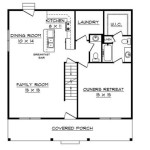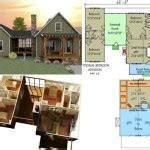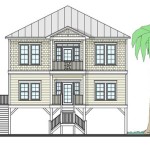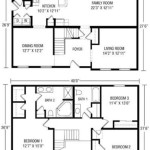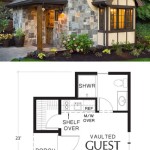When designing or renovating a home, one of the most important aspects to consider is the floor plan. A well-designed floor plan can maximize space, improve flow, and create a more livable environment, while a poorly designed one can lead to cramped quarters, awkward traffic patterns, and wasted space. Understanding the various aspects of house plan layouts can help you make informed decisions about your own home design.
A house plan layout, also known as a floor plan, is a diagram that shows the arrangement of rooms and spaces within a house. It indicates the size and shape of each room, as well as the location of doors, windows, and other features. Floor plans are essential for planning the construction or renovation of a home, as they allow builders and contractors to visualize the space and determine the best way to utilize it.
There are many factors to consider when designing a house plan layout. These include the number of occupants, their lifestyle, and the desired level of privacy. It is also important to consider the flow of traffic through the home, as well as the placement of furniture and other objects. With careful planning, it is possible to create a house plan layout that meets the needs of all occupants and creates a comfortable and inviting living space.
When designing a house plan layout, there are many factors to consider. Here are 10 important points to keep in mind:
- Number of occupants
- Lifestyle of occupants
- Desired level of privacy
- Flow of traffic
- Placement of furniture
- Size and shape of rooms
- Location of doors and windows
- Natural lighting
- Energy efficiency
- Budget
By considering all of these factors, you can create a house plan layout that meets the needs of all occupants and creates a comfortable and inviting living space.
Number of occupants
The number of occupants is one of the most important factors to consider when designing a house plan layout. The number of people who will be living in the home will determine the size of the home, the number of bedrooms and bathrooms, and the overall layout of the space. A home that is too small for its occupants will feel cramped and uncomfortable, while a home that is too large will be inefficient and.
- One or two occupants: A small home with one or two bedrooms and one bathroom may be sufficient for one or two occupants. The layout should be simple and efficient, with the living space, kitchen, and bathroom all located on the same floor.
- Family of three or four: A family of three or four will need a home with at least three bedrooms and two bathrooms. The layout should include a dedicated living room and dining room, as well as a family room or playroom for the children. The master suite should be located on the opposite side of the house from the children’s bedrooms for privacy.
- Family of five or more: A family of five or more will need a home with at least four bedrooms and three bathrooms. The layout should include a dedicated living room, dining room, family room, and playroom. The master suite should be located on the opposite side of the house from the children’s bedrooms for privacy.
- Multi-generational family: A multi-generational family will need a home with multiple bedrooms and bathrooms, as well as separate living spaces for the different generations. The layout should be designed to provide privacy for all occupants, while also allowing for interaction and.
It is important to consider the number of occupants when designing a house plan layout to ensure that the home is for all who live there.
Lifestyle of occupants
The lifestyle of the occupants is another important factor to consider when designing a house plan layout. The way that people live their lives will impact the design of the home, from the number of bedrooms and bathrooms to the layout of the kitchen and living room. Here are a few things to consider:
- Entertaining: If you enjoy entertaining guests, you will need a home with a spacious living room and dining room. The kitchen should also be large enough to accommodate multiple cooks and guests. You may also want to consider adding a wet bar or butler’s pantry.
- Cooking: If you love to cook, you will need a kitchen that is both functional and stylish. The kitchen should have plenty of counter space, storage, and appliances. You may also want to consider adding a kitchen island or breakfast nook.
- Working from home: If you work from home, you will need a dedicated home office. The office should be located in a quiet area of the house and have plenty of natural light. You may also want to consider adding a built-in desk or shelving.
- Hobbies: If you have any hobbies, such as painting, music, or woodworking, you will need a space in your home to pursue them. This space could be a dedicated hobby room, a workshop, or even just a corner of the basement.
By considering the lifestyle of the occupants, you can create a house plan layout that meets their needs and creates a comfortable and inviting living space.
Desired level of privacy
The desired level of privacy is another important factor to consider when designing a house plan layout. Some people prefer open floor plans with minimal walls and doors, while others prefer more private spaces. The level of privacy that is right for you will depend on your lifestyle and personal preferences.
- Open floor plans: Open floor plans are characterized by large, open spaces with minimal walls and doors. This type of layout can create a sense of spaciousness and allow for easy flow between different areas of the home. However, open floor plans can also be less private, as there is less separation between different spaces.
- Closed floor plans: Closed floor plans are characterized by more traditional room layouts, with separate rooms for different functions. This type of layout can provide more privacy, as there are more walls and doors to separate different spaces. However, closed floor plans can also be less spacious and can make it more difficult to flow between different areas of the home.
- Semi-open floor plans: Semi-open floor plans are a compromise between open and closed floor plans. This type of layout typically has a few open spaces, such as the living room and dining room, but also has some more private spaces, such as the bedrooms and bathrooms. Semi-open floor plans can provide a good balance of privacy and spaciousness.
- Universal design: Universal design is a type of design that is accessible to people of all ages and abilities. Universal design principles can be incorporated into house plan layouts to create homes that are more accessible and comfortable for everyone. For example, universal design features such as wider doorways, ramps, and roll-in showers can make it easier for people with disabilities to move around the home.
By considering the desired level of privacy, you can create a house plan layout that meets your needs and creates a comfortable and inviting living space.
Flow of traffic
The flow of traffic refers to the way that people move through a space. When designing a house plan layout, it is important to consider the flow of traffic to ensure that people can move around the home easily and safely. Here are a few things to consider:
- Main traffic patterns: The main traffic patterns in a home are the paths that people take from the entrance to the different rooms in the house. These paths should be clear and unobstructed, and they should not cross through any private areas, such as bedrooms or bathrooms.
- Secondary traffic patterns: Secondary traffic patterns are the paths that people take to less frequently used areas of the home, such as the laundry room or the garage. These paths can be more narrow and winding than main traffic patterns, but they should still be safe and easy to navigate.
- Circulation spaces: Circulation spaces are areas of the home that are used for movement, such as hallways and foyers. These spaces should be large enough to accommodate the flow of traffic without feeling cramped or crowded.
- Transitions: Transitions are the areas where different types of spaces meet, such as the transition from the living room to the dining room. These areas should be designed to create a smooth and seamless flow of traffic.
By considering the flow of traffic, you can create a house plan layout that is easy and safe to navigate for all occupants.
In addition to the above considerations, there are a few other things that you can do to improve the flow of traffic in your home:
- Use furniture to define spaces: Furniture can be used to define different spaces within a room and to create a more organized and efficient flow of traffic. For example, a sofa can be used to create a seating area in the living room, and a bookcase can be used to divide the living room from the dining room.
- Add rugs to define pathways: Rugs can be used to define pathways and to create a more inviting and comfortable space. For example, a rug can be placed in the entryway to define the path to the living room, and a rug can be placed in the living room to define the seating area.
- Use lighting to create a sense of flow: Lighting can be used to create a sense of flow and to make a space feel more inviting. For example, recessed lighting can be used to illuminate hallways and other circulation spaces, and pendant lights can be used to create a focal point in a room.
By following these tips, you can create a house plan layout that is easy and safe to navigate, and that creates a comfortable and inviting living space for all occupants.
Placement of furniture
The placement of furniture is an important part of house plan layout. Well-placed furniture can create a comfortable and inviting space, while poorly placed furniture can make a space feel cramped and uncomfortable. Here are a few things to consider when placing furniture:
### **1. Function**The first thing to consider when placing furniture is its function. What is the purpose of the space? Is it a living room, a dining room, a bedroom, or a home office? Once you know the function of the space, you can start to think about what kind of furniture you need and where to place it.
For example, in a living room, you will need to place furniture that is comfortable and inviting, such as a sofa, chairs, and a coffee table. In a dining room, you will need to place furniture that is functional and stylish, such as a dining table and chairs. In a bedroom, you will need to place furniture that is comfortable and relaxing, such as a bed, a dresser, and a nightstand. In a home office, you will need to place furniture that is functional and efficient, such as a desk, a chair, and a filing cabinet.
### **2. Flow**Once you have considered the function of the space, you need to think about the flow of traffic. How do people move through the space? Where are the entrances and exits? You need to place furniture in a way that does not obstruct the flow of traffic.
For example, in a living room, you should place furniture in a way that allows people to easily move around the room and to access the different seating areas. In a dining room, you should place furniture in a way that allows people to easily move around the table and to get to their seats. In a bedroom, you should place furniture in a way that allows people to easily move around the room and to get to the bed. In a home office, you should place furniture in a way that allows people to easily move around the room and to access the different work surfaces.
### **3. Scale**The scale of the furniture is also important to consider. The furniture should be in proportion to the size of the room. For example, a large sofa will overwhelm a small room, while a small sofa will look lost in a large room.### **4. Style**The style of the furniture should also be considered. The furniture should complement the overall style of the room. For example, traditional furniture will not look good in a modern room, and modern furniture will not look good in a traditional room.
By considering all of these factors, you can place furniture in a way that creates a comfortable, inviting, and functional space.
Size and shape of rooms
The size and shape of rooms are important factors to consider when designing a house plan layout. The size of a room will determine how many people can comfortably occupy it, and the shape of a room will determine how furniture can be arranged. Here are a few things to consider when determining the size and shape of rooms:
### **1. Function**The first thing to consider is the function of the room. What is the purpose of the space? Is it a living room, a dining room, a bedroom, or a home office? Once you know the function of the space, you can start to think about what size and shape will work best.
For example, a living room should be large enough to accommodate a sofa, chairs, and a coffee table. A dining room should be large enough to accommodate a dining table and chairs. A bedroom should be large enough to accommodate a bed, a dresser, and a nightstand. A home office should be large enough to accommodate a desk, a chair, and a filing cabinet.
### **2. Flow**The flow of traffic is another important factor to consider. How do people move through the space? Where are the entrances and exits? You need to make sure that the size and shape of the room does not obstruct the flow of traffic.
For example, in a living room, you should make sure that the furniture is arranged in a way that allows people to easily move around the room and to access the different seating areas. In a dining room, you should make sure that the furniture is arranged in a way that allows people to easily move around the table and to get to their seats. In a bedroom, you should make sure that the furniture is arranged in a way that allows people to easily move around the room and to get to the bed. In a home office, you should make sure that the furniture is arranged in a way that allows people to easily move around the room and to access the different work surfaces.
### **3. Proportion**The proportion of a room is also important to consider. The room should be in proportion to the size of the house. For example, a large room will look out of place in a small house, and a small room will look out of place in a large house.### **4. Shape**The shape of a room can also affect the way that it is used. For example, a square room can be used for a variety of purposes, while a long and narrow room may be better suited for a specific purpose, such as a hallway or a gallery.
By considering all of these factors, you can determine the size and shape of rooms that will work best for your home.
In addition to the above considerations, there are a few other things to keep in mind when determining the size and shape of rooms:
- Ceiling height: The ceiling height can also affect the way that a room is used. A room with a high ceiling will feel more spacious and airy, while a room with a low ceiling will feel more cozy and intimate.
- Natural light: The amount of natural light that a room receives can also affect the way that it is used. A room with a lot of natural light will feel more inviting and cheerful, while a room with less natural light will feel more dark and gloomy.
- Views: The views from a room can also affect the way that it is used. A room with a view of the outdoors will feel more connected to nature, while a room with a view of a wall will feel more closed in.
By considering all of these factors, you can create a house plan layout that is both functional and beautiful.
Location of doors and windows
The location of doors and windows is an important factor to consider when designing a house plan layout. Doors and windows provide access to the outside world and allow natural light and ventilation into the home. Here are a few things to consider when determining the location of doors and windows:
- Natural light: Windows should be placed in a way that allows natural light to enter the home. This will help to reduce energy costs and create a more inviting and cheerful living space. South-facing windows are the best for bringing in natural light, but windows on other sides of the house can also be effective.
- Ventilation: Doors and windows should also be placed in a way that allows for cross-ventilation. This will help to keep the home cool and comfortable in the summer months. Windows on opposite sides of the house are ideal for cross-ventilation.
- Privacy: The location of windows should also consider privacy. Windows should not be placed in areas where they will overlook neighboring properties or public areas. Bathrooms and bedrooms should have windows that are placed high on the wall or that are obscured by landscaping.
- Security: The location of doors and windows should also consider security. Doors and windows should be placed in a way that makes it difficult for intruders to enter the home. Doors should be solid and have deadbolts, and windows should have locks.
By considering all of these factors, you can determine the location of doors and windows that will create a functional, comfortable, and secure home.
Natural lighting
Natural lighting is an important factor to consider when designing a house plan layout. Natural light can help to reduce energy costs, create a more inviting and cheerful living space, and improve your overall health and well-being. Here are a few things to consider when designing a house plan layout to maximize natural lighting:
Orientation: The orientation of your home on your lot will have a big impact on the amount of natural light that you receive. Homes that are oriented to the south will receive the most natural light, followed by homes that are oriented to the west and east. Homes that are oriented to the north will receive the least amount of natural light.
Window placement: The placement of windows in your home will also affect the amount of natural light that you receive. Windows that are placed on the south side of your home will allow in the most natural light, followed by windows that are placed on the west and east sides of your home. Windows that are placed on the north side of your home will allow in the least amount of natural light.
Window size: The size of your windows will also affect the amount of natural light that you receive. Larger windows will allow in more natural light than smaller windows. However, it is important to find a balance between the size of your windows and the amount of privacy that you desire.
Overhangs: Overhangs can be used to block out the sun during the summer months and to allow in the sun during the winter months. This can help to reduce energy costs and create a more comfortable living space. However, it is important to design your overhangs carefully so that they do not block out too much natural light.
By considering all of these factors, you can design a house plan layout that maximizes natural lighting and creates a more inviting and comfortable living space.
Energy efficiency
Energy efficiency is an important factor to consider when designing a house plan layout. An energy-efficient home can save you money on your energy bills, reduce your carbon footprint, and create a more comfortable living space. Here are a few things to consider when designing a house plan layout to maximize energy efficiency:
- Orientation: The orientation of your home on your lot will have a big impact on its energy efficiency. Homes that are oriented to the south will be more energy-efficient in the northern hemisphere, as they will receive more sunlight in the winter months when heating is needed. In the southern hemisphere, homes that are oriented to the north will be more energy-efficient.
- Insulation: Insulation is one of the most important factors in determining the energy efficiency of a home. Insulation helps to keep the heat in during the winter and the cool air in during the summer. Be sure to insulate your walls, attic, and floors to the recommended levels for your climate zone.
- Windows and doors: Windows and doors are another important factor in determining the energy efficiency of a home. Choose energy-efficient windows and doors that have a high R-value. R-value measures the resistance to heat flow, so a higher R-value means that the window or door will be more energy-efficient.
- Appliances: The appliances that you choose for your home can also have a big impact on its energy efficiency. Choose energy-efficient appliances that have the Energy Star label. Energy Star appliances meet strict energy efficiency standards set by the U.S. Environmental Protection Agency.
By considering all of these factors, you can design a house plan layout that maximizes energy efficiency and creates a more comfortable and affordable living space.
Budget
The budget is an important factor to consider when designing a house plan layout. The cost of building a home can vary depending on a number of factors, including the size of the home, the materials used, and the complexity of the design. It is important to set a budget before you start designing your home so that you can make informed decisions about the size, style, and features of your home.
- Size of the home: The size of the home is one of the biggest factors that will affect the cost of building. A larger home will require more materials and labor to build, and it will also be more expensive to heat and cool. When determining the size of your home, it is important to consider your needs and lifestyle. How many bedrooms and bathrooms do you need? How much space do you need for entertaining? Once you have a good understanding of your needs, you can start to determine the size of the home that you can afford.
- Materials used: The materials used to build your home will also affect the cost. Some materials, such as brick and stone, are more expensive than others, such as vinyl and aluminum. When choosing materials, it is important to consider your budget as well as the climate in which you live. Some materials are better suited for certain climates than others.
- Complexity of the design: The complexity of the design will also affect the cost of building. A home with a simple design will be less expensive to build than a home with a complex design. When designing your home, it is important to keep your budget in mind and to choose a design that you can afford.
- Other factors: In addition to the size, materials, and complexity of the design, there are a number of other factors that can affect the cost of building a home. These factors include the cost of land, the cost of labor, and the cost of permits and inspections. It is important to factor in all of these costs when setting your budget.
By considering all of these factors, you can set a budget that will allow you to build the home of your dreams.










Related Posts

